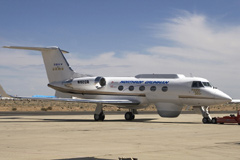
| Northrop Completes
First Phase of Airborne BAMS System Risk Reduction Testing |
|
|
6/19/2007 - WASHINGTON -- Northrop Grumman Corporation successfully completed the first phase of system-level flight testing for its Broad Area Maritime Surveillance (BAMS) Head Start risk reduction effort. The program used Northrop Grumman's Gulfstream II (G-II) test bed aircraft to validate how an Internet Protocol (IP)-based wireless network can be used effectively to transfer data from an unmanned aircraft to a prototype Mission Control Station (MCS) located in Hollywood, Md. The testing validated the addressed network management of IP-based publish-and-subscribe architecture using multiple narrow-band communications links. The Advanced Mission Management System (AMMS), central to the Northrop Grumman BAMS offer, demonstrated the open architecture of the hardware and software by being able to quickly incorporate the functions necessary to support these test flights. "The team successfully exercised the open nature of the AMMS to host new and pre-existing software by effectively using an IP-based communications solution to link payloads with the Navy's information network as represented by our prototype ground segment in Maryland," said Bill Beck, Northrop Grumman BAMS Head Start program manager. "This validates the benefits of the Navy's mandate to use open system architecture principles to reduce system development costs." During both test flights, the AMMS prototype installed on the G-II aircraft received real-time Automatic Identification System track data from ship traffic in the Pacific and transmitted it through two independent narrow-band communications links (UHF and L-band) to a local ground station. This data was then sent in near-real-time via the Internet to the prototype MCS, where the data was integrated on an unclassified global command and control system display. During a second series of test flights in July and August, Northrop Grumman will continue to mature its Multi-Function Active Sensor (MFAS) Active Electronically Scanned Array (AESA) radar, incorporate a dual Common Data Link (CDL) system, and incorporate a network and bandwidth management system emulating an Automated Digital Network System router to downlink data to the MCS. "In preparation for these flights, the test hardware and software undergo integration testing in the Global Hawk System Center using the same management processes that will be used during the System Design Development (SDD) program," said Matt Shihadeh, Head Start Flight Test program manager. "The prototype radar and dual CDL links have performed well in the lab and are being moved to Mojave, California, for installation on the G-II test aircraft." This first phase of flight testing validated the IP-based mission management architecture Northrop Grumman is offering for the BAMS program. Phase Two will address specific communications, network and sensor performance points applicable to BAMS. Ongoing integration and flight testing have validated the software development/re-use approaches planned for the BAMS SDD program. The overall effort has been designed to maximize applicability to BAMS to minimize SDD risks as well as to reduce the cost and schedule required to integrate the initial software release for the BAMS system. BAMS will supply the U.S. Navy with a persistent global intelligence, surveillance and reconnaissance (ISR) system to protect the fleet and provide a capability to detect, track, classify, and identify maritime, littoral and land targets. The Northrop Grumman RQ-4N BAMS team includes Northrop Grumman as prime contractor and team leader, unmanned aerial vehicle supplier and developer of the Multi-Function Active Sensor active electronically scanned array radar and the Night Hunter II electro-optical infrared sensor; L-3 Communications providing communications integration; Raytheon supporting the Mission Control System segment; and Rolls-Royce providing the aircraft engine. Source: Northrop Press Release |
| |
